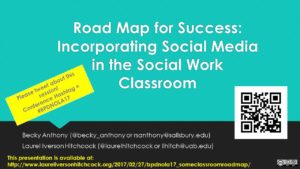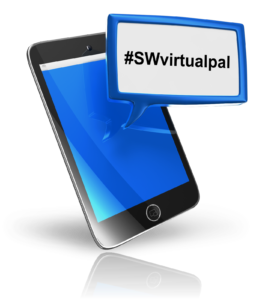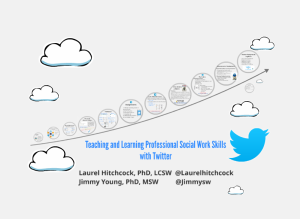#BPDNOLA17 – Road Map for Success: Incorporating Social Media in the Social Work Classroom
 At BPD in 2016, I attended a wonderful session by Drs. Becky Anthony and Jennifer Jewell of Salisbury University titled Building student connection by utilizing social media in the social work classroom. They graciously wrote about this presentation in a blog post – Social Media How-To Guide for Social Work Educators. Today (Saturday, March 4th), Becky and I will be presenting about how we both are the using guidelines that she and Jennifer developed, giving examples from our own teaching and classroom assignments. Please join us at 8:00 AM in Bayside B at the Sheraton in New Orleans for our presentation.
At BPD in 2016, I attended a wonderful session by Drs. Becky Anthony and Jennifer Jewell of Salisbury University titled Building student connection by utilizing social media in the social work classroom. They graciously wrote about this presentation in a blog post – Social Media How-To Guide for Social Work Educators. Today (Saturday, March 4th), Becky and I will be presenting about how we both are the using guidelines that she and Jennifer developed, giving examples from our own teaching and classroom assignments. Please join us at 8:00 AM in Bayside B at the Sheraton in New Orleans for our presentation.
Here is a link to the slides from our presentation: https://www.slideshare.net/laurelhitchcock/bpdnola17-road-map-for-success-incorporating-social-media-in-the-social-work-classroom
Also, information about developing professional social media guidelines for the classroom can be found here.
Here is our abstract with the learning objectives:
Teaching with Infographics: My experiences with digital literacy and non-traditional students
Nathalie P. Jones, PhD, MSW is an Assistant Professor of Social Work at Tarleton State University. In this blog post, Dr. Jones writes about her experiences creating and implementing an infographic assignment with nontraditional social work students.
As an Assistant Professor of Social Work at Tarleton State University, I have absolutely enjoyed educating social work students on the use of technology through macro social work practice courses. I teach a large number of non-traditional learners (those who have been out of school for longer than one year, and are employed, parenting, or in any other roles that are competing with being a learner as defined by the National Center for Education Statistics [2015]). I find that they develop student groups quickly in order to have support while working on assignments, especially those assignments that include the use of digital technology.
To help my students improve their understanding of digital and social technology, I have introduced the use of infographics during an advanced social work course entitled Women’s Issues. Infographics are visual representations of almost any type of information. Infographics are similar to storytelling with visual content and supported with statistical data. They are an effective way to communicate large amounts of information in a clear and succinct way, and are an increasingly popular tool in popular media and the non-profit world (NonProfit Tech for Good, 2014). Understanding how to create, share and evaluate infographics is a key digital literacy skill for social workers (Shelly, 2015). Along with all these benefits, I wanted to create an assignment that was fun and engaging for my nontraditional students who are often nervous about nontraditional, digital assignments.
For the Women’s Issues course, I asked students to research an issue or social problem affecting women, turn that research into an infographic (rather than a written paper), and then share their infographics with professionals outside of the class as a way to network with alliances who advocate on behalf of women. This meant students needed to not only create a quality artifact for a grade, but also learn how to share it with other advocates in a public way – via social media. In an effort to support learners who were experiencing technology in college for the first time, I provided them with seven detailed steps to successfully complete the infographic assignment. These steps involved learning about Twitter as well as creating an infographic.
Here are the assignment steps directly from the course syllabus:
Step 1: Create a Twitter Account & provide your Twitter Handle. *Don’t forget to follow the instructor.
Step 2: Research & provide a resource of two infographics (1) from the web and (1) from Twitter related to Women’s Issues. Then, provide a 1-2 page comparison on how the infographic was distributed, what was learned & why this is a resource for issues related to women.
Social Work Educator’s Guide for #SWVirtualPal
This guide to explains the hashtag #SWVirtualPal and how you might incorporate it into course content, a class assignment or learning activity. You can also download a PDF version of this guide.
The purpose of the #SWVirtualpal hashtag is to create professional connections between social work students, practitioners, and academics across the planet. It was created by Amanda Taylor from the University of Central Lancashire in the United Kingdom, and Laurel Iverson Hitchcock from the University of Alabama at Birmingham in the United States. To learn more about #SWVirtualPal, read this blog post.
Why #SWVirtualpal in Social Work Education?
 Pen Pals have been a ‘thing’ for a very long time. The earliest record of their usage, that we can find, is reported as being led by an ‘innovative Iowa teacher’ called Birdie Matthews, who at the time employed the methodology to bring the realities of WW II into the classroom (Myers-Verhage, 1995). Matthews creativity in the classroom quite possibly led to one of the most famous pen pal relationships of all time, and this was between Juanita Wagner (her student at the time) and Anne Frank. So why are we telling you all of this? Well, before the internet the likelihood of a social work academic in the US, working closely and supportively with a social work academic in the UK would have been ‘virtually’ unheard of, or indeed a fairly disparate affair, which would have been laborious to maintain. However, thankfully for us technologies have changed the way we work and the way we connect. Today’s digital and social media present all sorts of possibilities and opportunities; and being social workers with our default set on creativity, we decided quite a way back now to exploit all it is that technology affords.
Pen Pals have been a ‘thing’ for a very long time. The earliest record of their usage, that we can find, is reported as being led by an ‘innovative Iowa teacher’ called Birdie Matthews, who at the time employed the methodology to bring the realities of WW II into the classroom (Myers-Verhage, 1995). Matthews creativity in the classroom quite possibly led to one of the most famous pen pal relationships of all time, and this was between Juanita Wagner (her student at the time) and Anne Frank. So why are we telling you all of this? Well, before the internet the likelihood of a social work academic in the US, working closely and supportively with a social work academic in the UK would have been ‘virtually’ unheard of, or indeed a fairly disparate affair, which would have been laborious to maintain. However, thankfully for us technologies have changed the way we work and the way we connect. Today’s digital and social media present all sorts of possibilities and opportunities; and being social workers with our default set on creativity, we decided quite a way back now to exploit all it is that technology affords.
#SWvirtualpal: Hashtagging for Connection
This post was written by myself and my colleague, Amanda Taylor from the University of Central Lancashire in the United Kindgom. Please check out Amanda’s work with ‘Use of Book Groups in Social Work Education’, which can be found on Twitter: @SWBookGroup. She is definitely one of my #SWvirtualpals.
 Pen Pals have been a ‘thing’ for a very long time. The earliest record of their usage, that we can find, is reported as being led by an ‘innovative Iowa teacher’ called Birdie Matthews, who at the time employed the methodology to bring the realities of WW II into the classroom (Myers-Verhage, 1995). Matthews creativity in the classroom quite possibly led to one of the most famous pen pal relationships of all time, and this was between Juanita Wagner (her student at the time) and Anne Frank. So why are we telling you all of this? Well, before the internet the likelihood of a social work academic in the US, working closely and supportively with a social work academic in the UK would have been ‘virtually’ unheard of, or indeed a fairly disparate affair, which would have been laborious to maintain. However, thankfully for us technologies have changed the way we work and the way we connect. Today’s digital and social media present all sorts of possibilities and opportunities; and being social workers with our default set on creativity, we decided quite a way back now to exploit all it is that technology affords.
Pen Pals have been a ‘thing’ for a very long time. The earliest record of their usage, that we can find, is reported as being led by an ‘innovative Iowa teacher’ called Birdie Matthews, who at the time employed the methodology to bring the realities of WW II into the classroom (Myers-Verhage, 1995). Matthews creativity in the classroom quite possibly led to one of the most famous pen pal relationships of all time, and this was between Juanita Wagner (her student at the time) and Anne Frank. So why are we telling you all of this? Well, before the internet the likelihood of a social work academic in the US, working closely and supportively with a social work academic in the UK would have been ‘virtually’ unheard of, or indeed a fairly disparate affair, which would have been laborious to maintain. However, thankfully for us technologies have changed the way we work and the way we connect. Today’s digital and social media present all sorts of possibilities and opportunities; and being social workers with our default set on creativity, we decided quite a way back now to exploit all it is that technology affords.
Our mutual interests in creative teaching methodologies and an awareness of the benefits of digitalization led to us connecting online, via twitter… neither of us can actually remember when or why but it is suffice to say our like-mindedness took control. A fairly recent Skype chat highlighted that us being together in the same space was not going to result in any other than trouble and it is in this blog that we would like to offer you all the opportunity to join us in our troublesome-ness. Why do we use the word trouble? Well we are all so busy and never have enough time to do everything we want to do … this was pretty much how the conversation went. But once we got past this the need to create and innovate overtook. We talked about connections and the benefits of being connected. We talked about geography and shared ideas and resources about ‘connectography’ (Khanna, 2016), and the way in which the world is becoming a smaller place and also a much more diverse place. We went on to think about our respective student groups and how we could facilitate their learning in terms of the wider world. This for one reason or another led us to the notion of peer support, communities of learning and the fact that exposure to knowledge did not need to be such a local affair. Within these creative moments we came up with the idea of social work pen pals. We thought about how pre-modern digitization – the pen and paper technologies – facilitated connections and how that we had at our fingertips Twitter, a device and the hashtag.
#SWDE2016 Teaching & Learning Professional Social Work Skills w/ Twitter
 On Day Two of the Social Work Distance Education Conference, I will be presenting a workshop about the work Jimmy Young and I have done with Twitter in the classroom. If you are at the conference today, please join me in the B& O Room at 3:45 PM for the workshop. Our work focuses on the growing awareness that Twitter, a micro-blogging social media platform, can be a valuable tool in social work education to help students develop and practice social work competencies. This workshop will inform participants about the development, implementation and assessment of different assignments using Twitter for teaching social welfare policy and macro social work practice. Sample assignments, practical tips and a demonstration of Twitter will be provided to participants. The learning objectives for the workshop include:
On Day Two of the Social Work Distance Education Conference, I will be presenting a workshop about the work Jimmy Young and I have done with Twitter in the classroom. If you are at the conference today, please join me in the B& O Room at 3:45 PM for the workshop. Our work focuses on the growing awareness that Twitter, a micro-blogging social media platform, can be a valuable tool in social work education to help students develop and practice social work competencies. This workshop will inform participants about the development, implementation and assessment of different assignments using Twitter for teaching social welfare policy and macro social work practice. Sample assignments, practical tips and a demonstration of Twitter will be provided to participants. The learning objectives for the workshop include:
1.Understand how the social media platform Twitter can be incorporated into assignments for social work courses to advance learning of the profession’s competencies.
2. Demonstrate how social work educators can assess attainment of competency among students using a social media assignment paired with a rubric for evaluation of the assignment’s learning outcomes.
3. Appreciate the role of professional collaboration in the development, implementation and assessment of social media-based assignments.
Here are some of the resources from the workshop:
Prezi Slides – Teaching & Learning Professional Social Work Skills w/ Twitter Workshop
How to Participate in a Live Twitter Chat – Tips for Social Workers



